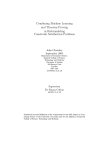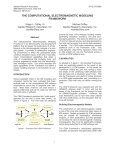Download Global Filtering for the Disjointness Constraint on Fixed
Transcript
TECHNICAL REPORT IC-PARC-04-02
Global Filtering for the Disjointness
Constraint on Fixed Cardinality Sets
Andrew Sadler and Carmen Gervet
IC-PARC
Centre for Planning and Resource Control
William Penney Laboratory
Imperial College London
London
SW7 2AZ
Global Filtering for the Disjointness Constraint
on Fixed Cardinality Sets
March 2004
Abstract
Finite set constraints represent a natural choice to model configuration design problems using set cardinality and disjointness, covering or partition constraints over (families of) set variables. Such constraints are available in most setbased constraint languages, often in the form of n-ary decomposable constraints.
The corresponding filtering algorithms make use of local bound consistency techniques. In this paper we show that when the set cardinality constraints are handled
together with the n-ary constraints, and set variable domains are specified by set
intervals, efficient global filtering algorithms can be derived. We consider the particular case of the n-ary disjoint constraint disjoint([X1 , . . . , Xn ], [c1 , . . . , cn ])
for a family of pairwise disjoint sets Xi of fixed cardinality ci . We present a set
of conditions and inference rules to infer Bounds Consistency (BC), together with
an efficient global filtering algorithm. We also explain why this level of pruning
cannot be achieved with a common FD formulation based on the alldiff constraint,
enriched with lexicographic ordering constraints; but is actually equivalent to a
dual FD representation based on the Generalized Cardinality Constraint.
1 Introduction and previous work
Finite set constraints solvers have been embedded in a growing number of CP languages such as Conjunto [7], Ilog Solver [11], MOZART [14], FaCiLe [2], CHOCO
[12] and shown their strengths in modelling configuration design problems such as
matching problems, and handling symmetries with a natural mathematical formulation
[6, 3]. Conjunto and its peers comprise the usual set operation symbols (∩, ∪, \), the
set cardinality relation (| |) and the set inclusion relation (⊆). For practical modelling
reasons most languages provide a set of n-ary constraints which are syntactic abstractions for a collection of respectively binary and ternary constraints. Set variables range
over set domains (sets of sets) specified by intervals whose lower and upper bounds
are known sets, ordered by set inclusion, e.g. X ∈ [{1}, {1, 2, 3}]. The lower bound,
denoted glb(X), contains the definite elements of the set (1) while the upper bound
lub(X), contains in addition the potential elements (2, 3). The constraint reasoning is
based on local bound consistency techniques extended to handle set constraints [8].
2
Previous studies in constraint programming have demonstrated the importance of
designing global filtering algorithms for specific classes of constraints. It has essentially been the realm of Finite Domain (FD) constraints pioneered by [4] and [15]’s
work on the alldiff. We are not aware of any global filtering method for some Finite Set constraints, except some preliminary results in [17]. In this paper, we show that
when the set cardinality constraints are considered together with n-ary set constraints,
a global filtering can be enforced efficiently.
In this paper, we consider the particular case of disjoint([X1 , . . . , Xn ], [c1 , . . . , cn ])
, an n-ary set constraint of pairwise disjoint sets of fixed cardinalities. Fixed cardinality sets occur in most configuration design problems and thus cover a large class of
practical problems. However, when the set cardinality is known, the global disjoint
constraint can be formulated by an equivalent FD model: i.e. where ci FD variables
are created to represent each set, with domain the l.u.b. of the corresponding set, and
the alldiff constraint is applied to all variables. Symmetries may be removed by
having a lexicographic ordering constraint between variables representing one set. For
example the constraint system over sets:
X in [{},{1,2,3,4}], Y in [{}, {1,3,4}]
disjoint([X,Y], [2,2])
can be modeled as:
X1,X2 in [1,2,3,4], Y1,Y2 in [1,3,4]
alldiff([X1,X2,Y1,Y2]), X1 < X2, Y1 < Y2
While both models are semantically equivalent, more pruning can be achieved with
the set model than its FD counterpart. The key lies in an inference rule, which we
define, that detects when an element must belong to a specific set (e.g. in the above
example, 2 must belong to X). The FD model can not enforce this addition because
there exist solutions with 2 assigned either to X1 (i.e. X = {2, 3} or X = {2, 4}) or to X2
(i.e. X = {1, 2}). The FD model introduces a disjunction which is not resolved by the
ordering constraints (meant to remove symmetries). The strengths of the set model and
global filtering we propose, come from the fact that 1) we can address the disjointness
together with the set cardinality constraints in a deterministic manner to infer BC, 2)
we do so at a computational cost similar to the alldiff filtering method [15].
Our contribution lies in the definition of a global satisfiability condition and two
inference rules, and the proof that they are necessary and sufficient to ensure satisfiability and BC for the disjoint([X1 , . . . , Xn ], [c1 , . . . , cn ]) constraint over sets of
fixed cardinalities. While implementing the inference rules as such would lead to an
exponential time complexity, we show how the proof procedure can be turned into an
efficient global
√ filtering algorithm which detects satisfiability and infers BC in polynomial O(ncv nc) time, where v is the size of the union of the set domains upper bounds
and c is the largest cardinality. The proof exploits Hall’s theorem and the application
of packing numbers to partially known sets (specified by set intervals).
We finally show how our algorithm compares with the GCC GAC algorithm[16],
when considering a dual FD representation of the disjoint constraint based on the Generalized Cardinality Constraint. This dual model holds because of the injective mapping between the elements and the sets (each element belongs to atmost 1 set).
3
2
Background
A fair amount of research has been devoted in configuration design to derive counting
functions that determine the maximum number of sets, with a given cardinality, allowed
in a known superset under some constraints [5]. The configurations are referred to
as t-designs where instances are solutions to partition and atmost constraints
“any two sets have atmost one element in common” (e.g. Steiner triple systems), or
t-packings where instances are solutions to disjoint and distinct constraints
over a family of unknown or partially known sets. The counting functions can be used
successfully to perform some global reasoning if they can be applied to partially known
sets. We use a counting function that derives the packing number which (we show) can
be applied when using set intervals to specify partially known sets.
To simplify the proof and discussion we assume from here on that all sets have the
same fixed cardinality c which we denote disjoint([X1 , . . . , Xn ], c) . This greatly
simplifies the reasoning of the proof without affecting the ability of the algorithm to
work on the original constraint. Indeed any arbitrary disjoint([X1 , . . . , Xn ], [c1 , . . . , cn ])
constraint can be transformed into a disjoint([X1 , . . . , Xn ], c) constraint. We do so
by simply padding the g.l.b.s of smaller set variables with new and distinct elements
until all sets have the same cardinality c. The two constraints clearly have exactly the
same solutions modulo the added elements.
2.1
Global disjointness and packing number
The disjoint([X1 , . . . , Xn ], c) constraint requires any two of the set variables to be
pairwise disjoint and of cardinality c. A solution to this constraint can be expressed as
a t-packing.
Definition 1 A t − (v, c, λ ) packing, or t-packing, is a collection of distinct subsets
(blocks) of a ground set A, where:
• Each block has c elements
• A has v elements, and is called the base set
• Any set of t elements of A appears in atmost λ blocks
• we have 0 < t ≤ c < v, and λ > 0.
A family of disjoint sets of same cardinality c, subsets of a known set A of size v,
forms a 1 − (v, c, 1) packing, since every single element in A should appear in atmost
1 set. This also holds for partially defined sets, where A is defined as the union of the
set domains l.u.b.’s. Thus we define all solutions to the disjoint([X1 , . . . , Xn ], c)
constraint to be 1 − (v, c, 1) packings where:
1) A = i:1...n lub(Xi ) 2) |A| = v
3) ∀i:1...n |Xi | = c
4) 1 ≤ c < v
S
For a given t − (v, c, λ ) packing, the packing number determines the maximum
number of sets that can exist in the packing. This number is not known or easily
4
derivable for all t-packings. However, it has been derived for some combinations of
parameters and also many bounds are known. For the disjointness constraint, the packing number is known and defines the maximum number of disjoint sets of size c that
we can build from a v-element superset. We have:
Definition 2 The packing number of a 1 − (v, c, 1) packing is b vc c.
It is worth noting that when the packing number (for disjoint sets) is exactly vc (ie when
n = vc ), we have a partition since all sets are disjoint and each element of the base set
will belong to exactly one set. This remark is core to our inference rules.
2.2
Hall’s theorem [9]
Let us now recall Hall’s theorem since we will make use of it in our proof of satisfiability and BC. Given a collection of subsets X1 , . . . , Xn of a v-set A, a System of
Distinct Representatives (SDR) for X1 , . . . , Xn is a family {e1 , . . . , en } of elements of A
satisfying the conditions
1) ei ∈ Xi for i = 1 . . . n
2) ei 6= e j for i 6= j
The first condition asserts that the elements are representatives of the sets, and the
second that they are distinct.
Hall’s theorem says that a family of finite sets has an SDR iff the union of any k
of the sets contains at least k distinct elements. Hall proved that this condition is also
sufficient for the existence of an SDR.
For example, the sets {1, 3}, {2, 4}, {1, 4}, {2, 5} possess an SDR since we can select the family {3, 2, 1, 5} to represent respectively each of the four sets. However, the
sets {1, 3}, {2, 4}, {1, 4}, {1, 2}, {2, 3} do not have an SDR since the five sets have only
4 distinct elements in their union, which is not enough to represent 5 sets.
Notations To simplify the coming discussion we introduce the following conventions. We use S to denote {X1 , . . . , Xn } (all the variables involved in the constraint).
Subsets of the problem variables (when required) will be referred to as U or R. A solution to a constraint is an assignment of values to variables such that the constraint is satS
isfied. We denote a solution by the mapping sol : S 7→ P(A) where A = X∈S lub(X).
3
Satisfiability
To achieve BC for the disjoint(S, c) constraint, there must be at least one solution to the constraint (both theoretically and algorithmically). This section gives necessary and sufficient conditions to determine satisfiability for the disjoint(S, c)
constraint.
The disjoint(S, c) constraint is set within a finite set constraint system, and
thus prior to satisfiability, the set domain constraints and associated set cardinality
constraints must be locally consistent. We recall such notions, together with the local
satisfiability condition for disjoint(S, c) , denoted SAT-0.
5
3.1
Local consistency[8]
The local consistency notions for the basic set domain and cardinality constraints are:
a.
b.
X ∈ [glb(X), lub(X)] ⇔ glb(X) ⊆ X ⊆ lub(X)
|glb(X)| ≤ |X| ≤ |lub(X)|
SAT-0 applies to a family S of pairwise disjoint sets. It ensures that definite elements
of a set (in the g.l.b.) are not available to any other set (not in the l.u.b.).
X ⊆ (lub(X) \ glb(Y ))
∀X,Y ∈ S,
Y ⊆ (lub(Y ) \ glb(X))
The constraint disjoint(S, c) is locally consistent iff the local consistency notions a. and b. hold together with SAT-0.
Consider the system of constraints:
X in [{1},{1,2,3,4,5}], Y in [{2},{1,2,3}],
Z in [{3},{3,4,5}], disjoint({X,Y,Z},2).
Applying SAT-0 prunes 1 and 3 from lub(Y ). This leads to a failure since Y is forced
to contain only the element 2 (the local consistency notion b. is not satisfied).
3.2
SDR and disjoint(S, 1)
It is hopefully clear that from an SDR {e1 · · · en } for the family of sets lub(X1 ) · · · lub(Xn )
we can construct a solution to a disjoint({X1 , . . . , Xn }, 1) constraint provided the
g.l.b. for all variables is empty. And vice-versa.
This statement does not generalize to sets of arbitrary cardinality c, nor to set variables with non-empty g.l.b.s. The following global satisfiability condition, SAT-1,
addresses these points.
3.3
SAT-1
SAT-1 exploits the packing number and the fact that any subset of a family of disjoint
sets is also a family of disjoint sets. Given a family S of pairwise disjoint sets of size c,
SAT-1 states that for any collection of sets U : U ⊆ S, the packing number associated
with the base set A (union of the upper bounds) must be greater than the size of U:
[
∀U ⊆ S, A =
lub(X),
X∈U
|A|
≥ |U|
c
Consider the system of constraints:
X in [{},{1,2,3,4}], Y in [{},{1,2,4,5}],
Z in [{},{1,3,5}], disjoint({X,Y,Z},2).
SAT-1 holds for all families of sets except one. For the family {X,Y, Z} we have:
A = {1, 2, 3, 4, 5}, |A| = 5 and 52 < 3, so the system is unsatisfiable.
6
Theorem 1 The constraint disjoint(S, c) , locally consistent in a finite set constraint system, is satisfiable iff SAT-1 holds.
Proof ⇒ Clearly if the constraint is satisfiable then we can build n disjoint sets of size c.
S
S
S
Thus ∀U ⊆ S we have |A = X∈U lub(X)| ≥ | X∈U sol(X)|, and also | X∈U sol(X)| =
|U| ∗ c since the sets sol(X) are all disjoint of size c. By transitivity we have |A| ≥
|U| ∗ c, thus SAT-1 holds.
⇐ Now let us assume that SAT-1 holds. We will show that it is always possible to construct a solution satisfying the constraint. We do so by reducing the initial
constraint to an equivalent disjoint constraint over S0 composed of new set variables
of cardinality 1 with empty g.l.b.s and showing that Hall’s theorem can be applied to
these l.u.b.s, to give a solution.
We generate for each set Xi ∈ S, c set variables Yi j ∈ [0,
/ li j ] of cardinality 1, such
that there is one new set for each element in glb(Xi ) and the remaining new sets have
the same l.u.b. as Xi . We have:
{x j }, jth element of glb(Xi )
li j =
lub(Xi ) otherwise
S
We will now show that ∀U 0 ⊆ S0 |A0 | ≥ |U 0 | where A0 = Y ∈U 0 lub(Yi j ), and hence
ij
by Hall’s theorem that a solution exists. To count the elements in A0 for an arbitrary
subset of variables U 0 , we partition U 0 into two disjoint sets U 00 and R00 , and count the
elements in each set separately.
We define U 00 as the set of all Yi j ∈ U 0 created from glb(Xi ) for which there is no
other Yi j0 ∈ U 0 created from lub(Xi ).
From SAT-0, the absence of any corresponding upperbound sets S
and the fact that
the sets are all singletons we get the following equality. |A0 | = |U 00 | + | Y ∈R00 lub(Yi j )|
ij
Combine this with the following equality based on the definition
of U 00 and R00 .
S
|U 00 | = |U 0 | − |R00 | to get |A0 | = |U 0 | + | Y ∈R00 lub(Yi j )| − |R00 |
ij
Now if we can show |
S
Yi j
∈R00
lub(Yi j )| ≥ |R00 | then we can conclude that |A0 | ≥ |U 0 |.
Define R0 = {Xi Yi j ∈ R00 } to be the projection of the variables R00 back to the origiS
S
nal problem variables. By definition of R00 , we have that Y ∈R00 lub(Yi j ) = X ∈R0 lub(Xi ).
ij
Hence SAT-1 gives us that |
S
Yi j
∈R00
i
lub(Yi j )| ≥ c ∗ |R0 |. Finally, the construction of S0
(and
consequently R00 ) ensures that c ∗ |R0 | ≥ |R00 |. By transitivity of ≥ we have shown
S
| Y ∈R00 lub(Yi j )| ≥ |R00 |.
ij
4
BC rules
We now define two global inference rules allowing for the necessary pruning to infer
BC for the disjoint(S, c) constraint.
Let us recall the definition of BC for our constraint domain[20]. In general terms, a
n-ary FD constraint is BC, if and only if any assignment from a variable’s domain can
be extended to a solution [13]. For finite set constraint systems this corresponds to the
following definition:
7
Definition 3 An n-ary set constraint is BC iff :
1. any element in the l.u.b. of a set variable appears in that set in at least one
solution,
2. any element which appears in the same set in all solutions must be part of the
g.l.b. of that set.
4.1
IR-2
IR-2 allows us to prune elements from the l.u.b. The inference rule says that when a
family of sets, U subset of S forms a partition of a base set A, all the elements in the
base set A become unavailable to all sets Y outside U (since they must be covered by
¯
one set in U). We define the partition condition for any U ⊆ S as follows:
[
partition(U, A, c) ⇔ A =
lub(U), |A| = |U| ∗ c
X∈U
and state IR-2 to be
∀ U ⊆ S, partition(U, A, c) ⇒ ∀Y ∈ S \U, X ∩ A = 0/
Consider the system of constraints:
[X,Y] in [{},{1,2,3,4}],
Z in [{},{3,4,5,6}], disjoint({X,Y,Z},2).
Applying IR-2 for the different families of sets we see that U = {X,Y } forms a partition of the base set A = {1, 2, 3, 4} (since |A| = |U| ∗ 2). Thus all the elements must be
covered by X and Y , implying that they should be removed from Z. This leads to the
final system of constraints:
[X,Y] in [{},{1,2,3,4}], Z = {5,6},
disjoint({X,Y,Z},2).
4.2
IR-3
IR-3 also makes use of the partition condition together with an additional condition
to add elements to g.l.b., that is elements that should be part of all solutions.
The basic idea is that if a subset U of S forms a partition of a base set A, and there
are elements e of A that occur in only one l.u.b. then such elements should be added to
the corresponding g.l.b., since they must belong to the partition and can not belong to
any other set. This is independent of whether such elements belong to l.u.b. outside the
partition or not.
∀ U ⊆ S, partition(U, A, c),
∃e ∈ A, ∃!X ∈ U|e ∈ lub(X) ⇒ e ∈ X
Consider a slight change to the previous example:
X in [{},{1,2,3,4}], Y in [{},{1,2,3}],
Z in [{},{3,4,5,6,7}], disjoint({X,Y,Z},2).
8
The set U = {X,Y } still forms a partition of the base set A = {1, 2, 3, 4} (since |A| =
|U| ∗ 2), but 4 occurs only in lub(X). Thus applying IR-3 leads to adding 4 to X:
X ∈ [{4}, {1, 2, 3, 4}]. The system of constraints at fixed point is:
X in [{4},{1,2,3,4}], Y in [{},{1,2,3}],
Z in [{},{5,6,7}], disjoint({X,Y,Z},2).
5
Prelude to BC
In the following section we prove that IR-2 and IR-3 are necessary and sufficient to
ensure BC for the global constraint disjoint(S, c) . In order to prove BC we make
use of a swap graph structure. Despite being defined in terms of the constraint and a
single solution, all solutions are contained within and can be generated from it.
Definition 4S Given a constraint CS= disjoint(S, c) andSa solution sol to C. We
define A = X∈S lub(X), B = A \ X∈S glb(X) and D = A \ X∈S sol(X). Let α be a
new set variable in [0,
/ B]. We extend sol for α with sol(α) = D. The swap graph
SG(C, sol) is the directed labeled graph
• whose node set is S ∪ {α}
e
• with edges X 7→ Y where e = sol(X) ∩ lub(Y ) and e 6= 0/
It follows that, for a given swap graph SG(C, sol) we have:
glb(X) = elements which appear on the self-edge only (not on any other outgoing
edge)
lub(X) = union of all labels in incoming edges (which terminate at X)
sol(X) = label on the self-edge.
e
Definition 5 An edge X 7→ Y is valid iff there is a solution with at least one element of
e appearing in sol(Y ).
e
Theorem 2 If an edge X 7→ Y is in a cycle, there exists a solution with at least one
element from e appearing in sol(Y ) (equiv. the edge is valid).
Proof Follows directly from the fact that a cycle can be seen as a permutation acting
on the current solution to produce a new solution. An edge in a cycle allows for the
rearrangement of the elements from X to Y where none are lost, added or changed (i.e.
permutation).
Theorem 3 An edge is valid iff there is a cycle involving the edge.
Proof ⇒ Suppose the edge is valid (i.e. there is a solution sol0 such that an element
e1 ∈ e appears in sol0 (Y )). sol0 can be described as a permutation of sol (since every
solution can be described as a permutation of every other solution). Furthermore since
any permutation can be expressed as a number of simple cycle permutations (see [5])
9
{1, 4}
X
{1}
{2, 3}
Y
{2, 3}
{1}
{2, 3}
{5, 6}
α
{5, 6}
Z
{7}
{7}
Figure 1: The swap graph of the previous example constraint for the solution sol(X) =
{1, 4}, sol(Y ) = {2, 3}, sol(Z) = {5, 6}.
of the form mentioned above, the permutation mapping sol to sol0 must contain a
cycle with an edge from X to Y labeled with e1 .
⇐ Theorem2
Theorem 4 A collection of nodes U ⊆ S
S is unreachable from the rest of the graph iff
U forms a partition of the base set A = X∈U lub(X).
Proof Split the nodes S into two sets U and U 0 where U is unreachable from U 0 . There
can be no edges originating in U 0 and terminating in U, hence all edges which terminate in U must also originate in U. This tells us that A, the union of all upperS
bounds (A = SX∈U lub(X)) is equal to the union
of the solution values appearing in
S
the sets (A = X∈U sol(X)). By definition | X∈U sol(X)| = |U| ∗ c, and so we have
partition(U, A, c) . Similarly any solution to a problem containing a partition
must assign all upperbound elements of the partition U to the sets in U and hence the
graph would have no incoming arcs from other nodes.
Corollary 1 The collection of all nodes which are unreachable from α represents a
partition. This follows as a special case of theorem 4.
Theorem 5 Within a minimal partition (one containing no sub-partitions) there is always a path from any node to any other node.
Proof Consider a minimal partition P of the nodes S. Now split P into two non-empty,
mutually disconnected subsets U and U 0 . By theorem 4 both U and U 0 must be partitions, but since P is a minimal partition this cannot happen. Thus we can conclude that
there can be no mutually disconnected subsets of P, equivalently there is always a path
between any two nodes.
10
Corollary 2 Minimal partitions are strongly connected components (SCCs) which are
unreachable from α. This follows directly from corollary 1 and theorem 5.
6
Key theorem and proof of BC
Theorem 6 A satisfiable disjoint(S, c) constraint is BC iff IR-2 and IR-3 hold.
The proof is in two parts following our definition of BC for finite set constraint
systems.
The first condition of BC says that for all sets, “any element in the l.u.b. of a set
variable appears in that set in at least one solution”. This is equivalent to saying that
all edges in SG(C, sol) are valid. We now prove that the elements excluded by IR-2
correspond exactly to the invalid edges in the swap graph.
Proof part 1
1. IR-2 seeks all partitions U and removes elements, covered by U, from l.u.b’s of
sets outside U. This corresponds to all the elements on edges leaving a partition,
e
X 7→ Y, X ∈ U,Y ∈
/ U.
2. By theorem 4, for all sets of nodes U in SG such that U forms a partition, there
can be no edges entering U. Thus leaving edges from U can not be part of any
cycle and are thus invalid (theorem 3).
3. Edges within a partition are necessarily within a minimal partition and by corollary 2 within an SCC, thus in a cycle. By corollary 3 those edges are valid.
Consequently IR-2 removes exactly all the invalid edges.
The second condition of BC says that for all sets, “any element which appears in
the same set in all solutions must be part of the g.l.b. of that set”.
part 2 We prove that the preconditions of IR-3 (X belongs to a partition and e
occurs uniquely in lub(X) within the partition) hold iff the element e appears in the set
X in all solutions (and hence must be added to the g.l.b.).
We do this by splitting the graph into the sub-graph U containing nodes reachable
from α and the sub-graph of nodes which are unreachable.
If X ∈ U, theorem 4 tells us that X is not in a partition (since U contains no partitions) and theorem 2 tells us that there is a solution where e does not appear in any set
in U.
If X ∈
/ U then by theorem 4, X is in a partition and hence e must appear in one
of the sets in the partition. Now consider that e occurs uniquely in lub(X) within the
partition, clearly e must appear in X in all solutions, hence IR-3 is necessary. To show
that it is complete, consider the case where there is another set Y in the partition s.t.
e ∈ lub(Y ). By theorem 5 there is a cycle involving the edge, hence by theorem 2 there
is another solution which assigns e to Y , hence IR-3 is sufficient.
11
7
Algorithm
The algorithm works by first creating and then maintaining a swap graph structure.
In order to create a swap graph we require an initial solution. To ensure satisfiability
(which is equivalent to applying SAT-1) we explicitly maintain and update a solution.
To find an initial solution, the problem is decomposed, as per the proof of satisfiability into a search for an SDR cast as a bipartite matching problem. The bipartite graph will have n ∗ c variable nodes, O(v) value nodes and O(n ∗ c ∗ v) edges.
We use the
p maximal matching algorithm
√ of Hopcroft and Karp [10] which runs in
O(|edges| |variable nodes|) ≡ O(ncv nc) time.
Once we have a solution we build a swap graph from the bipartite graph (containing
the matching) in time O(n2 c) by the algorithm below. The swap graph is stored as an
adjacency matrix.
funct MakeSwapGraph(bipartitegraph, matching)
for i = 1 to n do
for l = 1 to c do
val ←− value assigned to variable i + l
for j = 1 to n do
if variable j is reachable from val
then add val to the edge from i to j
To achieve BC we compute all SCCs which do not contain α (equiv. minimal partitions) using Tarjan’s[19] algorithm which runs in O(|edges| + |nodes|) ≡ O(n2 + n)
time and a breadth first search from α which runs in O(n2 ) time. Any edges leaving an
SCC are removed (in constant time each) and the l.u.b. of the corresponding variable
pruned, as per IR-2. Any singleton elements in an SCC are added to the associated
g.l.b. as per IR-3 again in O(n2 c). This procedure we call SCCPruning.
begin
bi ←− MakeBipartiteGraph(Sets)
matching ←− MaximalMatching(bi, Sets)
sg ←− MakeSwapGraph(bi, matching)
SCCPruning(sg)
end
√
The overall time complexity of this algorithm is then O(ncv + ncv nc + n2 c + n2 c).
With the simplifying assumption that the number of elements is always larger than
the number
of sets (ie. v ≥ n and hence O(n2 c) ≡ O(ncv)), we have a complexity of
√
O(ncv nc).
7.1
Incremental updates
Having achieved a state of BC, we can do better than repeat the above algorithm should
the domains of our variables change. We can incrementally update our swap graph
structure in O(n2 v) time for single element domain changes (thus ensuring satisfiability) and re-run the SCCPruning procedure to re-establish BC. The updates are achieved
12
by finding cycles like those used in the proof of BC, and modifying the graph according
to the permutation of the solution which the cycle represents.
8
Models and complexity comparison
Though the discussion focuses on all sets having the same fixed cardinality c, our
algorithm works unaltered when each set has different (but still fixed) cardinality.
As mentioned earlier in the paper, it is possible to model the disjoint(S, c)
constraint using FD variables constrained to be different. Assuming such an alldiff
constraint is solved using the global filtering algorithm [15] and any intra-set ordering
constraints are solved using standard arc or bound consistency.
1) Both algorithms detect failure in the initial problem with the same time complexity since they use the same bipartite graph modelling.
2) While the two algorithms are similar in time complexity, it is impossible with
the FD model to guarantee BC, as we illustrated in the introduction, since addition of
an element to the g.l.b. of a set variable as part of pruning, can only be approximated
in the FD model.
However, we can model the problem in another way, by having a FD variable corresponding to every element of the base set where the value assigned to the variable
indicates the set in which this variable occurs. Using such a model, we can constrain
the number of times a given value (set identifier) appears in the list of variables (set
elements) to be the cardinality of the set. The Global Cardinality Constraint (GCC) of
[16] can be used to enforce GAC on the FD model which corresponds to BC on the
set model. Consider a disjointness constraint on the family of sets {S1 ,..,Sn } of fixed
S
cardinality c. Let A = i Si and |A| = m. A dual finite domain representation is such
that:
1. We have m FD variables: ∀ j ∈ A, X j ∈ D = {1, .., n}.
2. For each i ∈ D the number of times i can be assigned to different X j is c = |Si |.
3. The solution equivalence between the two models is:
X j = i iff j ∈ Si
The network flow model which forms the basis of the GCC constraint works because there is an injective mapping between the elements and sets (as the alldiff
constraint has an injective mapping between variables and values). In the more general
case of t − (v, k, λ ) packing problems there are no injective mappings, instead there are
surjective mappings. In our work, were unable to construct network flow models for
these surjective problems and so derived our combinatorial counting arguments. We
believe that recent results in combinatorial theory, in particular the generalisation of
Hall’s theorem to arbitrary hypergraphs[1] may lead to proof schemes for these more
general cases which can in turn be converted to effiecient algorithms.
13
9
Acknowledgements
A shorter version of this paper was submitted to AAAI-04. The authors would like to
thank one reviewer in particular for his thorough review and comparison with the GCC
algorithm.
10
Conclusion and future work
This paper showed that it is possible to efficiently enforce global consistency on nary set constraints. While Hall’s theorem forms the theoretical basis for important
global FD constraints, we showed that it can be extended to n-ary set constraints using
packing numbers. We described a global filtering approach to detect satisfiability and
ensure BC for the disjoint([X1 , . . . , Xn ], [c1 , . . . , cn ]) constraint. From our global
satisfiability condition, inference rules and proof, we gave an efficient polynomial time
algorithm to achieve and incrementally maintain BC, which is not be possible using
the most obvious FD formulation, though is possible for the dual model using the GCC
constraint.
We implemented the constraint in the ECLi PSe system, building on the ic_sets
library [18]. Preliminary experimental results indicate that the algorithm performs well
compared to local propagation and demonstrates the expected benefits of maintaining a
level of consistency which is independent of the search strategy. Future work comprises
further experimental studies including a combination of global constraints with symmetry breaking for problems modelled with sets. We are also interested in identifying
which level of consistency can be achieved when dealing with bounded cardinalities
and a generalization of the inference rules to any t − (v, c, λ ) packing problem.
References
[1] Ron Aharoni and Penny Haxell. Hall’s theorem for hypergraphs. Journal of
Graph Theory, 35(2):83–85, 2000.
[2] N. Barnier and P. Brisset. Facile : A functional constraint library. In CICLOPS’01, 2001.
[3] N. Barnier and P. Brisset. Solving the Kirkman’s Schoolgirl Problem in a Few
Seconds. In Proc. CP-02, 2002.
[4] N. Beldiceanu and E. Contejean. Introducing Global Constraints in CHIP. In
Elsevier Science, editor, Mathematical Computation Modelling, volume 20(12).
1994.
[5] C. Berge. Principle of combinatorics. Academic Press, 1971.
[6] Torsten Fahle, Stefan Schamberger, and Meinholf Sellman. Symmetry breaking.
In Proc. CP-01, pages 93–107, 2001.
14
[7] Carmen Gervet. Conjunto: constraint logic programming with finite set domains.
In Proc. ILPS-94, 1994.
[8] Carmen Gervet. Interval Propagation to Reason about Sets: Definition and Implementation of a Practical Language. CONSTRAINTS journal, 1(3):191–244,
1997.
[9] P. Hall. On Representatives of Subsets. J. of London Math. Soc., 10:26–30, 1935.
[10] J E Hopcroft and R M Karp. An n5/2 algorithm for maximum matchings in
bipartite graphs. SIAM Journal on Computing, 2(4), 1973.
[11] ILOG Inc. ILOG Solver, User Manual, 1997.
[12] Francois Laburthe. Choco: implementing a cp kernel.
constraints.net/, September 2000. In TRICS CP-00.
http://www.choco-
[13] A. Mackworth. On reading sketch maps. In IJCAI’77, pages 598–606, 1977.
[14] Tobias Müller. Solving set partitioning problems with constraint programming.
In Proc. PAPPACT’98, March 1998.
[15] Jean-Charles Regin. A filtering algorithm for constraints of difference in csps. In
Proc. AAAI-94, 1994.
[16] Jean-Charles Regin. Generalized arc consistency for global cardinality constraint.
In Proc. AAAI-96, 1996.
[17] Andrew Sadler and Carmen Gervet. Global reasoning on sets. In FORMUL’01
worshop in conjunction with CP-01, 2001.
[18] Joachim Schimpf, Andrew M Cheadle, Warwick Harvey, Andrew Sadler, Kish
Shen, and Mark Wallace. ECLi PSe . Technical Report 03-1, IC-Parc, Imperial
College London, 2003.
[19] R E Tarjan. Depth-first search and linear graph algorithms. SIAM Journal on
Computing, 1(2):146–160, 1972.
[20] Toby Walsh. Consistency and propagation with multiset constraints: A formal
viewpoint. In Proc. CP-2003, 2003.
15




























